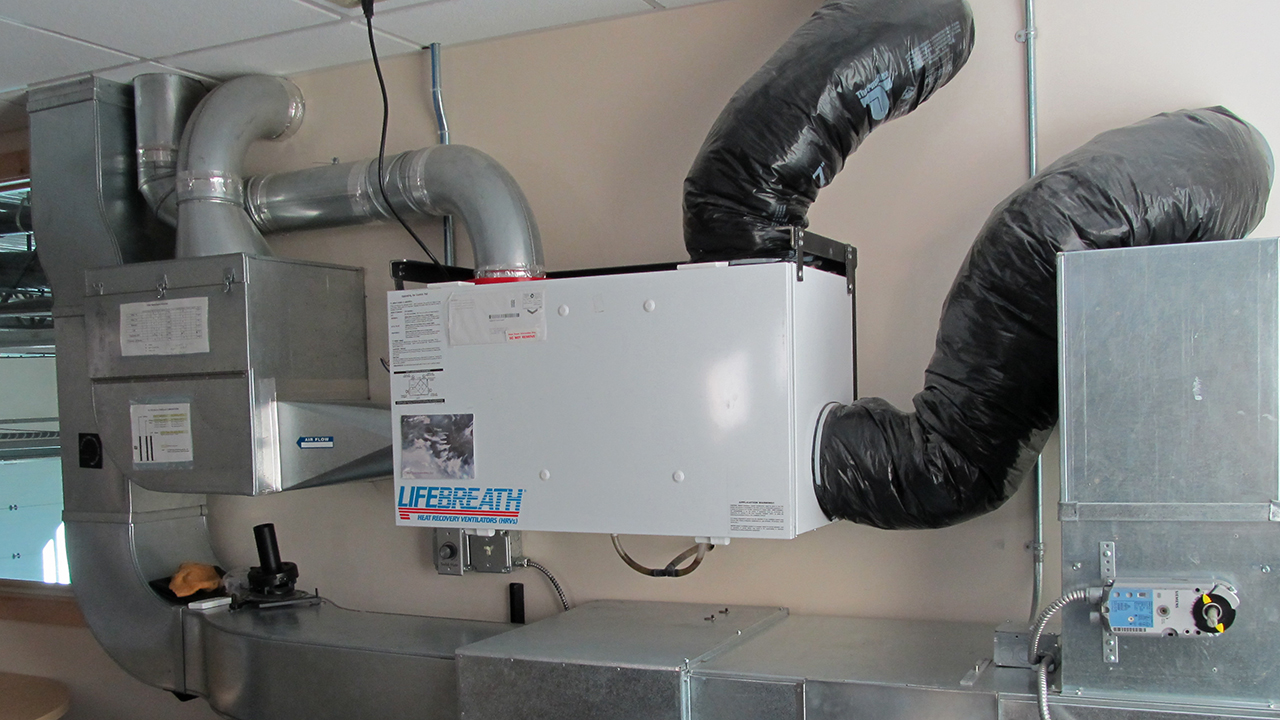What’s an HRV and why do I need one?
While providing continuous ventilation to your house, HRVs use stale exhaust air to condition fresh incoming air. In the winter, this means that incoming fresh air is warmed by out-going exhaust air–which creates less drafts than ventilation systems that simply bring in cold outdoor air without preheating it. Recycling heat contained in exhaust air also uses less energy than having to use your heating system to warm up outdoor air. The heat is exchanged as supply and exhaust airstreams pass through a core located inside an HRV.
The HRV core allows heat to transfer to incoming air without the airstreams mixing. The warmed fresh air is then distributed through a home using ducts and circulating fans while the exhaust air is vented outside. How well an HRV is able to pre-heat the supply air depends on several factors – the temperature of the indoor air, the temperature of the outside air, the flow rate through the HRV, and the HRV’s efficiency. More efficient HRVs are able to recover more heat from the exhaust air and transfer it to the supply air. When comparing the efficiencies of HRV models, it is important to understand that there are different efficiencies that may be listed by the manufacturer and that these efficiencies are calculated differently. Additionally, these efficiencies vary depending on the difference between indoor and outdoor temperature, and the flow of air through the HRV.
The Sensible Recovery Efficiency (SRE) quantifies the amount of heat recovered by the incoming fresh air from the exhaust air. It is reported as a percentage of the total heat that is available for recovery. For instance, if an HRV has an SRE of 55% for a given flow rate and temperature difference, this means that the HRV core transfers 55% of the heat available in the out-going air to the incoming airstream. The measurement and calculations for the SRE correct for a number of events that add heat to the incoming air in a realistic situation, such as heat that might enter the airstream through the HRV case, airflow imbalances between the supply and exhaust airstreams, heat gains from circulating fans, and energy that might be used to defrost the HRV core. The SRE is often used to compare the heating season performances of HRVs because it calculates the efficiency of an HRV independent of different circumstances (such as flow rates, temperatures, and heat gains) in installed locations.
The Apparent Sensible Effectiveness (ASE) is another efficiency often listed by HRV manufacturers. Unlike the SRE, the ASE is calculated by including the heat transfer from inefficient fans to the airflow, heat leaking in or out of the HRV case, and any leaks between the airstreams when the cross through the HRV core. It is also expressed as a percentage and is equal to the temperature rise of the incoming outdoor air divided by the temperature difference between indoor and outdoor air. Typically, it will be higher than the SRE for a given HRV, air flow, and temperature difference because it includes heat gained by the incoming air from sources other than the exhaust air. Ultimately, the ASE provides the final delivered supply air temperature at a given flow rate for an HRV – and thus is used to predict the final delivered air temperature at a given flow rate.
With energy recovery ventilators, or ERVs, manufacturers may also report a third efficiency, the total recovery efficiency (TRE). This efficiency gives the net energy that is recovered by the ERV, which includes the sensible (temperature) heat and latent (moisture) heat that is recovered. It is similar to the SRE, except that it also includes the moisture recovered from the exhaust air.
When comparing the efficiencies of different HRVs, first ensure that reported efficiencies were measured in an independent lab. Second, take care to compare equivalent efficiencies. For instance, the SRE of one HRV at a given air flow and temperature should be compared to the SRE of another HRV at the same air flow and outdoor temperature, not to the ASE or TRE. This will ensure that you are comparing HRVs measured in equivalent circumstances. If you would like to explore the reported efficiencies for a wide variety of HRVs, visit the website of the Home Ventilating Institute, a non-profit institution that provides performance certification of residential ventilation products. Their website contains a directory of certified HRVs and their efficiency ratings (www.hvi.org).





